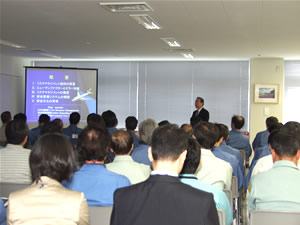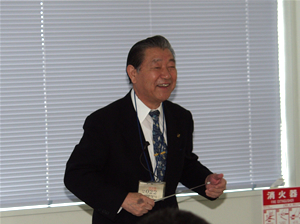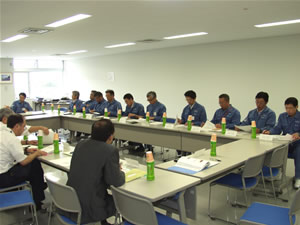|
|
 |
|
The 96th Safety Caravan was conducted at Tomari Power Station of Hokkaido Electric Power Co., Inc. in Tomarimura, Hokkaido Prefecture on July 12, 2007.
|
| Safety Presentation |

|
|
During the Safety Presentation
|
Approximately 50 employees of Tomari Power Station of Hokkaido Electric Power Co., Inc. and affiliated companies attended the Safety Presentation.
The presentation began with an opening salutation from Mr. Takashi Kumagai, Plant Manager of the Tomari Power Station. "Today's presentation marks the third Safety Caravan for Tomari Power Station. Since the commencement of operation of Tomari Power Station, operation of Units No. 1 and 2 has proceeded relatively smoothly. However, looking at the overall national picture surrounding the nuclear power industry, conditions are very austere, and there have been some major social issues uncovered during general inspections of power generating facilities, including the problem at our own Date Thermal Power Station. We are very grateful to be able to hold this Safety Caravan at a time like this. Taking the opportunity of today's Safety Caravan, we believe we can raise the level of safety awareness one notch higher and make useful contributions to electric power generation operations hereafter."
After the opening remarks, Mr. Kawashima, member of Japan Nuclear Technology Institute board of directors, introduced an overview of the activities of our organization, followed by a lecture from Capt. Akira Ishibashi, Director of the Research and Development Section of the Japan Institute of Human Factors Inc., who spoke on the topic "Considering Safety and the Human Factor."
|
Lecture highlights |

|
|
Capt. Akira Ishibashi,
Director of the Research and Development Section
of the Japan Institute of Human Factors Inc.
|
●In recent-year civilized society, we have introduced the latest high-tech systems into everything from production lines to daily life, and we enjoy an advanced level of convenience. But behind the scene, the sense of perils that we face tends to be remarkably thin, so we are told. Still, systems are led by progress, and between these systems and the humans who use the systems, there are case after case of occurrences of "human-machine interface problems," and just one tiny little system mishap or a very trivial error in operation have the potential of leading to a major disaster. And so, great precision is required of the persons making use of such systems, but there are limits to human faculties. In order to compensate for these limits to individual abilities, organization has been instituted so that even if errors do occur, measures have been arranged for the purpose of containing the resultant damages. One of such organizational endeavors is the conception of risk management systems.
●The most important factors in the advancement of risk management activities are the understanding of human factors and the guarding against human errors. By understanding basic human nature and characteristics of conduct, or the factors that hinder a person's ability, the mechanism of human error can be clarified, and the construction of effective countermeasures against errors can be pursued. When we analyze human errors in detail, we can understand that behind the party that caused the error, there is a latent organizational error that induced it. Endeavors directed at organizational errors have progressed for many years in the aviation industry, and as a result, new training techniques (CRM training) has been developed, and it has been bearing fruit in the form of a system of learning from past mistakes (the Aviation Safety Reporting System). That system is the foundation of safety culture in the aviation industry, and the results can be seen from the statistics on aviation accidents from around the world over the past ten years.
●In the aviation industry, organizational endeavors "From Tombstone Safety to Preventive Safety" directed at the human factor are evolving. Tombstone safety refers to safety that stems from accidents in where there have been precious sacrifices, and traditional safety techniques have relied totally on such techniques. However, as aircraft evolved into jumbo size, a single accident turned into a major disaster, and so thoughts began turning toward "it is too late after an accident already happens." In other words, this gives rise to the idea of preventing accidents before they happen by grasping an accurate understanding of the latent risk factors during the course of routine work, analyzing them, and formulating the countermeasures.
These and other very valuable points were brought up during the lecture.
|
In the questionnaire after the presentation, the following opinions were expressed.
●I am currently undergoing training in analysis of the basic factors (RCA), and one of the analysis techniques, SAFER, is also based on the study of the human factor, so I was very interested in the explanation of the similar VTA analysis techniques.
●I think the CRM training is an effective form of training for those who work in the central control room of the nuclear power station and for the maintenance-work team.
●I listened with great interest to the accounts concerning the aviation industry, another field that places a great deal of importance upon safety.
●I was very pleased to be able to listen to the systematic talks about such things as what are errors, what are the categories, why do they occur, and what countermeasures should we take. Especially the general concept of CRM is a very useful reference (it made me aware of the importance of gut instinct).
●CRM training (errors that experts are prone to making) was especially interesting. I believe we need to have sufficient knowledge and experience, and be confident and have pride, but there is only a thin line between this and self-conceit, thus we need continuous vigilance and self-admonition.
●The lecture really drove home the importance of preventive safety for me, in the transition from tombstone safety to preventive safety, as the form of risk management. I felt the important indispensability of nurturing every required item in the establishing of safety culture.
●As far as the various insights into human error are concerned, it was a highly significant lecture from the perspective of systematic explanation with examples of actual cases mixed in.
|
Safety information exchange session |

|
|
During the Safety information exchange session
|
At the request of Tomari Power Plant, Hokkaido Electric Power Co., Inc., Mr. Hirokazu Fukui, Senior Researcher on the Human Factors Research Project, Institute of Nuclear Safety System Incorporated presented a detailed introduction of "Investigation of the Workplace Climate" to the safety information exchange session, which was followed by exchanges of opinions. |
|
|







